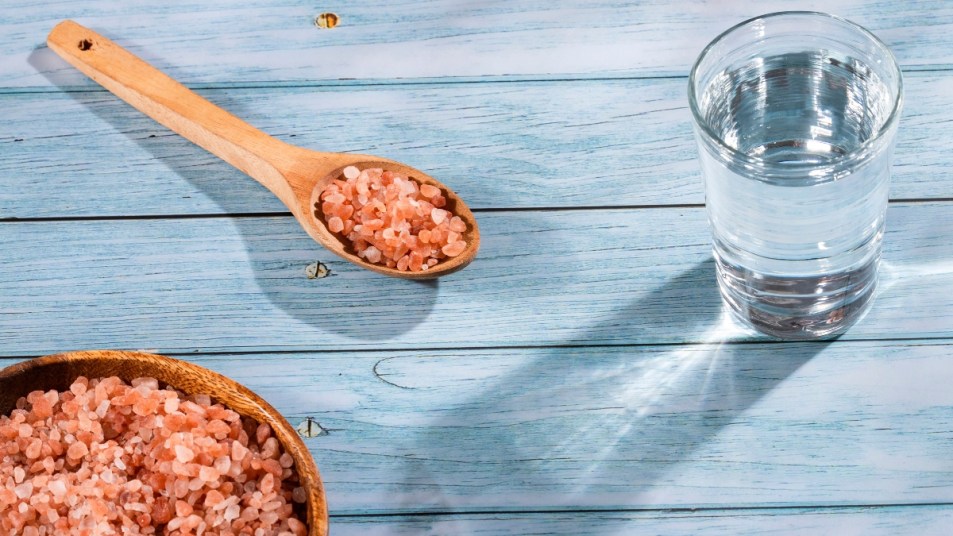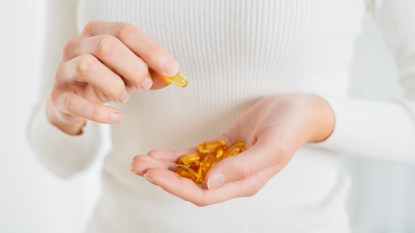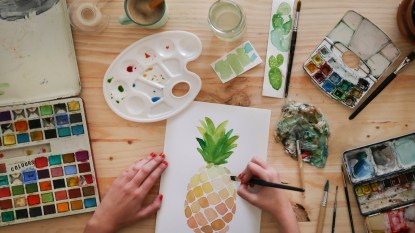Scientists: Adding a Pinch Of Pink To Your Water Will Leave You Feeling Younger, Happier and Smarter
It will also help ward off almost all common major diseases!

If the benefits that we all get from being fully hydrated were a pill, it would be worth millions of dollars for some fortunate pharmacology company. Lucky for you, it’s not! Because the real secret to achieving the optimal levels of hydration that help you to ward off major health problems like depression, dementia, chronic tiredness, brain fog and diabetes is as close to your salt shaker — if you fill it with Himalayan pink salt. Here, what hydration is, why it matters and the easiest way ever to ensure that you reap all of the benefits.
What is hydration?
“Every action of every cell requires hydrating water for proper function,” explains Gerald Pollack, Ph.D., a leading water researcher at the University of Washington in Seattle. “If any of those cells hasn’t enough hydrating water, it won’t function properly.”
The solution seems simple: Just guzzle more water. Problem is, our cells actually have a hard time absorbing plain water. As James DiNicolantonio, Pharm.D., notes: “True hydration is replenishing water plus lost salt and minerals.” There can even be a danger in drinking too much plain water. (For more on this, see a story on Liquid IV in our sister publication).
How do I know if I’m dehydrated?
Odds are you’re suffering from some degree of dehydration right now. Cornell University experts estimate 75% of us are chronically dehydrated. And you can’t rely on thirst to safeguard against hydration — your thirst response doesn’t kick in until til your fluid levels drop by 1% to 2%.
By that time, you’re likely already feeling the effects of dehydration. University of Connecticut experts say symptoms such as fatigue, brain fog and headaches can set in when fluid levels dip by a mere 1.5%.
Luckily, there’s a reliable hydration indicator: “You’ll know you’re well hydrated by your urine color, which should be pale yellow rather than dark yellow or amber,” notes Teresa Murray Amato, M.D., chairwoman of emergency medicine at Long Island Jewish Forest Hills hospital.
7 major health benefits of staying hydrated
Keeping your fluid levels up delivers total-body benefits. Some of the biggest perks:
Hydration makes you feel younger — and live longer
In fact, a National Institutes of Health study suggests optimal hydration cuts the odds of feeling older than your years by 33%. Plus, the same study found sidestepping dehydration slashes the risk of longevity-hampering diseases like heart failure, dementia, stroke and diabetes by 41%.
Hydration boosts your mood and energy
Findings in The Journal of Nutrition reveal staying well-hydrated optimizes activity in higher-order brain regions that govern mood. The result: Significant drops in tension, anxiety, anger and hostility. Plus, a study in the World Journal of Psychiatry found folks with higher hydration levels were 44% less likely to suffer from depression than their chronically dehydrated counterparts. Click through to learn how adding lemon to your water can help you look and feel great
And in an uplifting bonus, higher-order brain regions also influence perceptions of fatigue. That’s why scientists reporting in The International Journal of Environmental Research and Public Health found correcting fluid shortfalls doubled energy levels.
Hydration wards off kidney disease
Hydration increases urine volume to flush stone-forming substances such as calcium and oxalates from kidneys. In a Harvard University study, high fluid intakes cut kidney stone risk by 42%. And as research in Obesity Facts notes, staying well-hydrated preserves the organ’s filtering functions. In their study, maintaining healthy hydration lowered the risk of chronic kidney disease by 50%.
Hydration balances blood sugar
Keeping your body’s fluid levels at their peak combats the blood sugar elevations that can lead to diabetes. In a Diabetes Care study, researchers found that adequate hydration decreased the odds of developing hyperglycemia (high blood sugar) by up to 32%. Study authors explain that hydration helps keep a lid on arginine vasopressin, a hormone that can cause blood sugar to climb.
Hydration reduces dementia risk
Dehydration thickens blood and lowers blood flow to the brain, robbing it of oxygen and other crucial nutrients. And since healthy blood flow removes damaging proteins from the organ, fluid deficits can lead to a buildup that’s been linked to declines in brain function and Alzheimer’s disease. Fortunately, findings in Nutrients suggest enhancing hydration protects against these problems to cut dementia risk by 50%.
With all the mind/body benefits proper hydration can deliver, it’s no wonder a growing number of experts recommend replenishing lost fluids by sipping water boosted with Himalayan pink salt.
How does Himalayan pink salt boost hydration?
Salt increases your thirst response to keep you drinking throughout the day. But as an electrolyte, salt also enhances hydration by pulling water into cells. Plus, it helps ensure proper fluid balance in spaces that surround cells as well as blood plasma. In fact, findings in the Journal of Clinical Investigation suggest salt-added fluids are 69% more hydrating than plain water.
But other electrolytes play crucial roles in hydration, too. And when it comes to providing a range of electrolytes, not all salts are created equal.
What makes Himalayan pink salt superior to table salt?
It’s packed with electrolyte minerals
The refined salt in most saltshakers is processed to give it that snow-white color, explains Fred Pescatore, MD. “This translates into a missed opportunity for the body, since refining leaves salt lacking in other hydrating electrolyte minerals like potassium, calcium and magnesium,” he notes.
Luckily, Himalayan pink salt gets it rosy hue from its rich supply of minerals. And those hydrating electrolytes are tops among them. In an analysis published in the journal Foods, pink salt samples contained up to 30 times more potassium, 15 times more calcium and 142 times more magnesium than white table salt.
Dr. Pescatore is far from pink salt’s only fan. “I love to add a pinch of pink Himalayan salt to the water I drink daily,” says Ann Louise Gittleman, PhD. “It’s a terrific way to enhance hydration, thanks to the electrolytes it contains.”
It balances fluid-regulating hormones
Prudence Hall, MD, founder of The Hall Center in Santa Monica California, notes Himalayan pink salt water also boosts levels of the hormone aldosterone. That’s key, since aldosterone helps the body hold onto fluids more efficiently.
“When aldosterone levels dip too low, the body loses more water than it retains,” she says. “The result is chronic subclinical dehydration, as well as fatigue and salt cravings.”
Plus, low aldosterone can result in increased urination, making the body even more dehydrated.
How can you get the benefits of Himalayan pink salt water?
The simple fix Dr. Hall suggests: Sipping 8 oz. of water mixed with ¼ to ½ tsp. of Himalayan pink salt twice a day.
Another pink salt proponent: Heather Moday, MD, who includes it in her recipe for an economical option to pricey electrolyte replacement drinks. To make, simply mix ¼ tsp. of Himalayan salt, the juice of half a lemon and 2 tsp. of raw honey (all of which are rich in nutrients that boost hydration) into 2 cups of water.
More smart ways to dodge dehydration
While Himalayan pink salt water is a superstar — Tufts University research suggests it boosts hydration in as little as five minutes — it’s not the only way to enhance your body’s fluid levels. Other simple, science-backed tricks:
Sip milk in the morning
Drinking a glass of milk with breakfast (or adding it to cereal or smoothies) deters dehydration from the day’s very start. Research in the American Journal of Clinical Nutrition found that milk keeps you 50% more hydrated than water for two hours.
Electrolytes in milk are partially responsible for the benefit. But milk’s macronutrients such as carbohydrates and protein also slow the emptying of fluid from the stomach to increase fluid absorption.
Give drinks a tropical twist
Like Himalayan pink salt, coconut water contains hydration-enhancing electrolytes like calcium, potassium and magnesium. And in a study in the Journal of the International Society of Sports Nutrition, coconut water proved as effective at replenishing fluids as a commercial sports drink. For an easy way to get the hydrating effects, replace plain water with coconut water in mocktails and smoothies.
Snack on watermelon
Or tuck into a salad. Enjoying two extra servings of fresh produce daily reduces your dehydration risk 42%, say investigators reporting in The American Journal of Clinical Nutrition. Fruits and veggies contain a form of fluid known as “gel water.”
And according to Dana Cohen, MD, gel water is twice as hydrating as plain water. While all fresh produce contains the fluid, you can find the highest levels in options such as watermelon, apples, berries, carrots, celery, citrus, cucumbers, grapes, greens, melon, pears, peppers, pineapple, tomatoes and zucchini.
Pop a mint
While it’s well-known that salt makes you thirsty, the sugar in sweet treats like mints and chewing gum does too. University of Texas Southwestern researchers say sugar turns on production of FGF21, a hormone produced by the liver.
And when FGF21 travels through the blood stream to the brain, it acts on a region known as the hypothalamus. This quickly stimulates thirst to prevent dehydration
Hit the snooze button
Permission to laze in bed a little longer: Researchers reporting in the journal Sleep found that snoozing 8 hours a night reduces your risk of dehydration by 59% compared to sleeping 6 hours or less.
During slumber, your body releases a hydration-regulating hormone called vasopressin. But when you don’t clock enough Zzzs, vasopressin production is cut short, which can leave you feeling parched and draggy.
Pretend you’re a plant
Are your plans to stay hydrated often foiled because you forget to sip regularly? Surveys show up to 80% of us don’t remember to drink up during busy days. Fortunately, research in Inquiry found that using a cell-phone app that issues hydration reminders can increase the amount of fluids you sip by 48%. One to try: Plant Nanny Water Tracker (free for iOS and Android), which waters a cute plant in your virtual garden each time you drink.
This content is not a substitute for professional medical advice or diagnosis. Always consult your physician before pursuing any treatment plan.
A version of this article originally appeared in our print magazine, Woman’s World.













